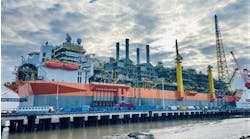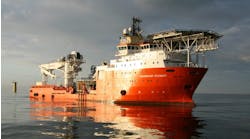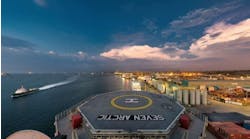LNG is being used increasingly for powering ships in the Norway fleet, including offshore vessels. It offers an environmentally friendly option, which has been welcomed by shipowners, oil companies, and authorities. Gothenburg-based CRYO has supplied all the on-board LNG equipment to date.
At present there are nine LNG-powered ships operating in Norwegian waters, three platform supply vessels (PSVs) and six ferries. A further 10 are on order, comprising one PSV, six ferries, and three coastguard vessels. All will again be equipped with LNG systems from CRYO, with deliveries due between 2008 and 2010.
The company is in talks concerning possible deliveries to a further two to four supply ships in the Norwegian sector, and has also had an enquiry from a US tug owner, according to managing director Gunnar Lennerås.
The idea of powering ships with LNG originally was proposed jointly with Eidesvik, a shipowner which now has two such PSVs in operation –Viking Energy and Viking Queen – and a third, Viking Lady, due for delivery this summer.
Initially the authorities, including the Norwegian Petroleum Directorate and the Norwegian Maritime Directorate (NMD), were skeptical, not least from a safety point of view, says Gunnar Trygg, CRYO’s business manager for plants and special equipment.
Gas is perceived as more hazardous than diesel. However, LNG is stored at low over-pressure, which usually makes it significantly safer than compressed gas, the use of which is forbidden below deck on ships in Norway. DNV carried out an extensive program of risk analysis, which concluded that the risk level for an LNG-fueled vessel was no higher than that for a diesel vessel, leading NMD to issue a regulation for LNG vessels.
Experience with LNG as a propulsion fuel indicates that the vessels perform as well on gas as on diesel, claims Lennerås. Initially the supply ships, which have dual gas/diesel systems, were intended to employ gas while transiting to and from offshore installations, and diesel while maneuvering at the platforms, but now they use gas for all operations. Some of the ferries are fast craft, which have no problem in achieving speeds of up to 21 knots with gas.
From a safety point of view, all has functioned as it should. The integrity of the LNG system on one of the ferries was put to the test when the vessel accidentally crashed into the quay, but the system was undamaged.
The main benefits of using LNG are environmental. Eidesvik has reported that, compared with diesel, carbon dioxide emissions from LNG are reduced by 23% and nitrogen oxide emissions by 89%. Moreover, there are no sulfur or particle emissions from LNG. These are important statistics for Norway, where shipping is responsible for about 40% of total NOx emissions.
In Norway the reduction in emissions generate significant savings as tax is charged on both CO2 and NOx emissions. And although the capital investment in an LNG-powered ship is about 12% higher than for a diesel-driven vessel, owners report an overall cost saving both from the lower price of LNG fuel and from reduced taxes for emissions.
As its name suggests, CRYO’s expertise lies in designing and supplying equipment for handling and storing gases at very cold temperatures. Part of the Linde group, it is one of only two companies in the world that can supply helium tanks capable of maintaining the contents at between -260 ºC and -269 ºC.
The system supplied to LNG-fueled ships consists of a storage tank, a bunkering system for transporting LNG from the ship’s side to the storage tank, and a vaporizer system to convert the liquid gas back to gaseous form ready for use in the engines.
The vacuum-insulated storage tank is double-skinned and made of stainless steel grade 304 with a typical wall thickness of 15 mm (0.6 in.). To remain in liquid form, LNG has to be stored at temperatures of around -160 ºC. Stainless steel gets stronger as it gets colder, which makes it suitable for this application. Air is pumped out of the space between the two skins to create a vacuum, and the space is filled with perlite insulating material.
The vaporizer system is contained in a “cold box” located at one end of the tank. The cold box is completely enclosed apart from vents in case of any leakage. Piping and valves also are stainless steel. As part of the vaporization process, the liquid gas is pressurized to 5 bar. To provide maximum protection against leakage, all piping and valve connections are welded -- flanges are not used. For the same reason valves are bellow-sealed.
The main drawback with LNG as a propulsion fuel is its volume – while its energy content by weight is equivalent to that of diesel, it occupies about twice as much space. The 234 cu m (8,264 cu ft) cylindrical tanks supplied by CRYO for use on supply ships are 17 m (55.8 ft) long, 6 m (19.7 ft) in diameter, and weigh 109 tons (8.88 metric tons).
Lennerås is optimistic that LNG will catch on as propulsion fuel in other parts of the world. The main obstacle is lack of availability, but he sees this logistical bottleneck easing as demand from potential customers grows. In Scandinavia, for example, the company has identified several projects under consideration for installing LNG terminals in both Norway and Sweden.
For more information contact Gunnar Lennerås, CRYO. Tel +46 3164 6947, fax +46 31 532220,[email protected], www.cryo.se




